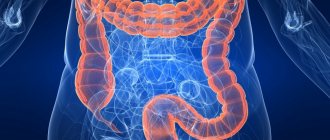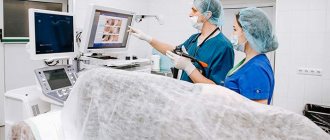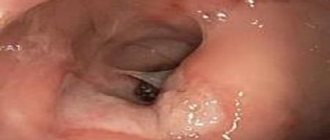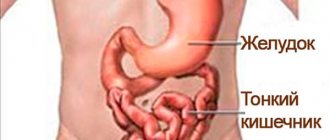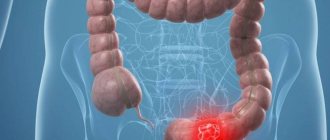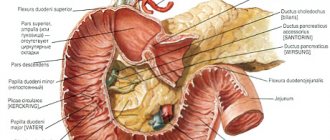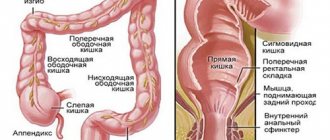Intestinal polyps are small single or multiple non-malignant tumor-like growths consisting of mucosal cells that appear on the inner surface of the loops of the affected organ.
Both children and adult men and women are susceptible to the development of pathology. Pathology occurs in any segment of the gastrointestinal system. The size of the outgrowths ranges from a few millimeters to 10 centimeters (sometimes more). Most often, polyps of the ascending colon and duodenum are detected. Tissue neoplasms in the small intestine are less commonly diagnosed.
The pathology occurs quite often: it is diagnosed in 9–18 people out of a hundred in the general population, and much more often (40–47%) in the age category of 50–55 years. Typically, intestinal polyps up to 2–3 cm in size do not show any signs and do not bother the patient. But if they are detected, then even the smallest growths must be removed so that they do not degenerate into cancerous formations.
What it is?
Intestinal polyps (ICD 10 code: K62.1) are fleshy growths that form in the cavities of the gastrointestinal tract or other hollow organs. This is a neoplasm (cluster of cells) of insignificant size, attached by a stalk or a wide base to the tissues and protruding into the cavity.
There are cases when polyps appear in entire colonies, covering a large area of the intestine. Minor formations (1–2 mm) are invisible, but with further development they are injured by feces, causing internal bleeding. Large growths can block the intestinal lumen and cause constipation.
This formation can appear regardless of age, and people who have inherited intestinal polyposis are at risk.
Are intestinal polyps cancer or not?
This question arises in many patients who have polyps found in their intestines.
Polyps are benign formations, they are not cancer, but some types can malignize (become malignant) over time. If polyps are detected during a colonoscopy, biopsy material is taken. Laboratory research makes it possible to determine the type of neoplasm, which makes it possible to draw a conclusion about the possibility of malignancy.
Classification
According to the histological structure, the types of polyps in the intestine are determined:
- Adenomatous appearance with a round and smooth but dense surface. It is usually covered with a vascular network, so it does not stand out. Its size can be large, which increases the risk of developing cancer.
- Villous appearance. These intestinal polyps grow over a wide area, forming a carpet as they are covered with villi. Of these, 40% can develop into a malignant tumor.
- The hyperplastic type grows to small sizes, their localization is the wall of the rectum.
- Hamartomatous appearance - formation occurs with healthy tissue. Their appearance is associated with unusual combinations of cells, but perhaps this is the result of anomalies.
- The juvenile form occurs in children. It has the appearance of a bunch of grapes hanging on a stem. Doesn't go into oncology.
An identified polyp in the intestine, the signs of which will allow us to determine what type it belongs to, needs to be treated. Depending on the stage of its development, the appropriate method of therapy will be selected.
Causes
Modern medicine does not have clear data on the etiology of intestinal polyposis. However, there are certain theories that suggest the mechanism of development of the disease:
- Global health problems for the majority of the population associated with environmental degradation. It is quite difficult not to notice the weakening health of modern people. First of all, this concerns children. The number of babies with severe congenital pathologies is constantly increasing. Many children suffer from diseases that were previously common only in old age. The process of polyp formation is also significantly influenced by factors such as eating foods with chemicals, physical inactivity, lack of fresh air in city living conditions, alcohol abuse, smoking, and poor diet;
- Chronic inflammation of the intestinal walls. It has been established that polyps cannot begin to form in healthy tissues. Therefore, this assumption regarding the cause of their occurrence seems most obvious. Inflammatory processes occurring in the mucous membrane cause the epithelium to regenerate faster, and this can result in uncontrolled growth. In addition, scientists point to a connection between the process of formation of intestinal polyps and diseases such as dysentery, ulcerative colitis, typhoid fever, enteritis, and proctosigmoiditis. The basis for this hypothesis is the disappearance of relapses of polyposis after getting rid of the listed diseases. In addition, constipation and intestinal dyskinesia can provoke the growth of polyps. It turned out that polypous growths are more often found in the place of the intestine where there was stagnation of feces and there were microtraumas;
- Genetics. It is believed that family history influences the development of the disease. This is confirmed by the fact that even against the background of absolute health, some children exhibit polypous growths. Scientists explain this fact by a genetic program that causes some parts of the intestine to work differently;
- Pathologies of the digestive system and blood vessels. The condition of the intestinal mucosa largely depends on the blood vessels. Varicose and diverticular disease, atherosclerosis have a negative effect. Pathologies of the digestive system (stomach ulcer, gastritis, pancreatitis, cholecystitis and others) cannot but affect the health of the intestines;
- Food allergies, gluten intolerance. While gluten intolerance was a rare problem just a few decades ago, more and more children are now suffering from this form of food allergy. When products containing this protein enter the body, the immune system begins to react violently to it. It perceives gluten as a foreign agent, which leads to damage to the mucous membrane lining the intestines. If an inadequate immune response is ignored, a person faces serious health problems, including intestinal cancer and the development of osteoporosis.
- Embryonic theory. Scientists hypothesize that those areas of the intestine in which polyp formation occurs were incorrectly formed during intrauterine development. Symptoms of the disease begin to appear somewhat later as a result of the influence of additional negative factors;
In addition to the fact that there are general reasons for the development of polyps in the intestines, the most probable factors for their formation in various sections have been put forward, for example:
- Rarely formed polypous growths inside the duodenum most often result from gastritis with high acidity, cholecystitis or cholelithiasis. The age of the patients ranges from 30 to 60 years;
- Even less often, formations are detected in the cavity of the small intestine. Moreover, they are combined with polyps in other parts of the intestines and in the stomach, and are more often diagnosed in women aged 20 to 60 years. The appearance of growths can be provoked by multiple factors, among which the inflammatory process is in the lead;
- Formations found in the colon are most often the result of negative heredity.
Clinic
It is extremely difficult to detect tumors in the early stages, and late stages often lead to death for patients. Tumors of the colon of non-cancerous origin are represented by villous polyps, lipomas, leiomyomas, fibromas, hemangiomas, dimphangiomas and others.
There are multiple or single adenomatous or glandular-villous polyps.
Lipomas
The formation of tumors in the submucosal layer of the membrane is accompanied by their large growth, reaching significant sizes. They are easily detected by palpation. These tumors put pressure on the intestine, cause signs of obstruction, and can cause intestinal volvulus. If medical assistance is not provided and urgent surgery is not performed, the patient will die.
If the mucous membrane covering a benign tumor is ulcerated, symptoms of colitis will appear, followed by intestinal bleeding. When diagnosing and general symptoms, lipomas should be distinguished from cancer by their density and rapid growth.
Polyps
They are tissue formations, often of an inflammatory nature. More often, they protrude above the surface of the mucosa on a stalk or have a flat base. All polyps grow towards the lumen of the colon.
These tumors form papillae called papillomatous papillae. They may contain mucous glands, thus producing their own secretion. They are called mucous polyps.
Another group of these tumors are vascular polyps. They are enriched with blood vessels and are capable of bleeding.
Fibrous polyps form in the rectosigmoid region near the anus. The danger is that a malignant neoplasm in the colon can develop according to the shape and type of development of polyps.
Polyps can be identified using an endoscope or x-ray. Polyposis can cause intestinal bleeding. Often intestinal polyps coexist with gastric forms. Polyps are treated in only one way - through surgery. Preventive examinations are required 1-2 times a year to check for relapse.
Villous tumors
They originate from adenomatous polyps. The growth of formations reaches large volumes (up to the size of an average apple). Equipped with branched villous elements. They secrete mucus in noticeable quantities and have a tendency to degenerate into malignant formations.
Symptoms and first signs
In the vast majority of cases, the presence of polyps in the intestines does not have any clinical symptoms or specific manifestations. This prevents timely detection and treatment of the disease.
The patient should be alert and consult a doctor if the following signs are present:
- pain in the abdomen;
- discomfort that occurs during defecation;
- blood on the surface and in the stool;
- mucous discharge during and after bowel movements;
- difficulties in moving feces, alternating with loose stools;
- frequent urge to defecate.
- Nonspecific symptoms of colon polyposis (blood in the stool) in adult patients may be mistaken for manifestations of hemorrhoids. Identifying the cause of bleeding in children is much more difficult, since it may not be related to the intestines.
Most patients with colon polyposis are characterized by localization of tumors on the left side of this organ. Having a mushroom-shaped (with a thick or thin stalk) shape, they can reach six centimeters, provoking the development of colitis and diseases of the colon.
A characteristic symptom indicating colon polyposis is the presence of longitudinal stripes of mucus and blood in the stool (the lower the location of the polyp, the brighter the color of the blood and the lesser the degree of its mixing with stool). In every second patient with polyps in the colon, constipation alternates with diarrhea and is combined with painful tenesmus. In addition, patients suffer from abdominal pain, burning and itching in the anal canal and rectum.
Constant diarrhea and bleeding worsen the general condition of patients, causing physical weakness, dizziness, pale skin and severe exhaustion.
- Rectal polyposis, which does not manifest itself for years, is most often detected during endoscopic examinations in patients over fifty years of age. When inflammation or damage to the integrity of these neoplasms occurs, the clinical picture changes dramatically. Patients experience copious discharge of mucus and blood. In this case, you should immediately contact a proctologist.
- Polyps localized in the sigmoid colon provoke the occurrence of regular constipation, followed by bouts of causeless diarrhea. Nonspecific symptoms of sigmoid colon polyposis are the presence of a swollen abdomen, belching, as well as the release of blood, pus and mucus during bowel movements.
- Polyposis of the small intestine, which is extremely rare, can nevertheless lead to the development of intestinal obstruction, profuse bleeding, intestinal volvulus, and disruption of the integrity of its walls. In both adults and children, implantation of one part of the intestine affected by polyps into another can occur. There is a high probability of malignancy of such polyps.
The initial symptoms of small intestinal polyposis include flatulence, nausea, heartburn, belching, a feeling of fullness in the stomach, and pain in the upper abdomen. The patient may experience cramping abdominal pain. Polyps located in the initial parts of the small intestine can provoke uncontrollable vomiting.
Polyps that have settled in the duodenum in 70% of cases do not bother patients in any way for quite a long time. When the tumors reach large sizes, patients experience pain and intestinal obstruction develops; the ulcerated membranes of the polyps begin to bleed.
The nature of the pain varies; They are usually localized in the navel area. In addition to pain, the patient complains of a feeling of fullness in the stomach, constant nausea and rotten belching.
When a polyp of the duodenum occludes the intestinal lumen, the food coma is retained in the stomach, provoking symptoms of intestinal obstruction: the patient experiences cramping pain, vomiting of eaten food, and splashing noise in the abdomen during auscultation.
However, based on the clinical picture alone, which resembles the manifestations of tumors of the bile ducts, small intestine and pyloric region of the stomach, it is impossible to diagnose the presence of duodenal polyps.
Disease prognosis and preventive measures
Further developments after surgical excision of polyps depend on the type of pathology and the general condition of the patient. A single small formation at a young age resolves without serious complications or relapses. The danger arises with multiple intestinal lesions and adulthood, when the immune system is weakened and there are a number of chronic diseases that aggravate the general anamnesis.
After surgery, doctors advise using preventive measures to prevent relapse:
- eliminate smoking and alcohol;
- enrich the diet with plant fiber and vitamins;
- drink at least 1.5-2 liters of liquid every day;
- monitor your own weight - extra pounds lead to recurrent illness;
- exclude fatty, smoked, spicy and fried foods;
- undergo regular scheduled examinations;
- At the first sign of discomfort, contact a gastroenterologist.
Sigmoid colon polyposis is a benign neoplasm, but with a high risk of developing cancer. It is impossible to leave the disease without treatment for fear of leading to serious complications. The danger of the pathology lies in the fact that at the early stage of development there are no pronounced symptoms, which complicates diagnosis. Proper nutrition and regular visits to the doctor can help prevent the disease.
Complications
Any formations in the intestines, especially polyps prone to malignancy, should not be ignored by specialists. They often form without additional signs, and a person may not be aware of their presence for many years until he is examined or obvious clinical manifestations of the disease appear. But why are polyps in the intestines so dangerous? Why do they need to be treated on time?
The main danger of polyps is magnetization. It is the risk of degeneration into cancer that worries specialists the most. Adenomatous polyps of the large intestine are especially dangerous. They are not prone to ulceration, and the patient does not know for decades that he is suffering from a precancerous pathology. The average rate of degeneration of a glandular polyp into cancer is 7–10 years. But experts prefer not to take risks and perform the operation immediately after detecting polypous growths.
With a long course and active growth, polyps can lead to the following complications:
- chronic constipation;
- bleeding;
- intestinal obstruction;
- prolonged flatulence;
- anemia;
- constipation, diarrhea;
- volvulus;
- perforation of the intestinal wall;
- chronic inflammation of the intestinal walls due to damage to the walls of the neoplasm.
To avoid complications, it is necessary to immediately contact a specialist for additional examination when the first symptoms of polyps appear in the intestines.
People with a history of inflammatory diseases of the gastrointestinal tract or unfavorable heredity are recommended to undergo regular preventive examinations by specialists. This will allow you to start early treatment and get rid of polyps in less traumatic ways.
Diagnostics
To reliably determine the diagnosis, it is important to conduct a whole range of examinations, including laboratory, instrumental and endoscopic research methods.
Intestinal polyps are the area of research of proctologists, endoscopists, gastroenterologists and oncologists.
After studying the patient’s complaints and physical examination, the following manipulations are prescribed:
- Rectal palpation of the rectum. Using fingers, the nearest parts of the colon are probed and the possible causes of unusual symptoms (hemorrhoids, inflammation, constipation) are determined.
- X-ray. An important study is irrigoscopy (x-ray using contrast). The method allows you to accurately determine pathological growths, vascular components and their volume. The route of administration of contrast is retrograde, that is, by enema into the rectal lumen. The disadvantage of the method is the inability to determine the smallest polyps. If the polyps are located in the high parts of the intestine, then the passage of barium through the intestine is examined. To do this, you need to drink the contrast agent. A few hours later, a series of x-rays are taken.
- Endoscopy. There are two main methods of endoscopic examination of the anorectal space: sigmoidoscopy and colonoscopy. The first method allows you to assess the condition of the intestine, the sections of which are located 25 cm higher, take materials for a biopsy, and visually assess the structure of the neoplasm. In the second case, the doctor has the opportunity to assess the condition of the intestine over a distance of 1.5 m, take a biopsy sample for histological and cytological examination, and immediately remove the pathological growth.
The World Health Organization (WHO) recommends diagnostic colonoscopy for everyone over the age of 55 years, and then every 10 years (if there are no complaints or symptoms characteristic of intestinal polyps). This recommendation is due to the fact that more than 85% of colon cancer cases are detected in patients over 60 years of age.
The age threshold for the first study is reduced to 45 years if polyposis or intestinal cancer have been identified in the family of first-degree relatives (mother, father, siblings), especially before the age of 45. Different countries have their own standards for including this procedure in the plan of medical examinations of the population. In many European countries, colonoscopy is recommended annually for all persons over 45 years of age, and the examination plan also includes a stool test for occult blood (Gregersen test).
If any complaints arise that may indicate the presence of this disease, colonoscopy is performed as prescribed by the doctor, regardless of the patient’s age. There are frequent cases of detection of benign polyps in children.
How to treat polyps?
Treatment of polyps should begin early. At the same time, the only effective method that allows you to recover from the disease is surgery. Conservative methods are also used for multiple formations that cover the gastrointestinal mucosa. However, wait-and-see tactics are followed for elderly patients who have contraindications to surgery.
Drug therapy in this condition involves prescribing the following drugs:
- Analgesics and antispasmodics are used for pain (No-shpa).
- Drugs to improve digestion.
- Remedies for bloating (Simethicone).
- Medicines to normalize stool.
- Immunomodulators and vitamins.
If a person’s polyps have reached large sizes, then they need to be removed surgically.
Surgical intervention
Common surgical techniques:
- Endoscopic polypectomy. Doctors sometimes combine this option with electrocoagulation of the base of the growth. Since this operation does not cause massive damage, the recovery period is minimal.
- Removal with a segment of intestine. Prescribed for almost circular tumors, large or multiple growths. Neoplasms are removed along with part of the intestine. If hereditary familial polyposis is diagnosed, then in this case the colon is completely removed.
- Transanal polypectomy. Polyps are removed using special scissors or a scalpel. Upon completion, the mucous tissues are sutured. Such operations are prescribed only when the polyps are located in close proximity to the anus. The cut-off is carried out under local anesthesia, and for the convenience of the specialist, the anus is spread apart with a rectal speculum.
- Laser removal. Prescribed for benign large formations with thick or wide bases.
- Polypectomy through an incision in the intestinal wall. It is prescribed when polyps are large or if they are located in a hard-to-reach area. During the operation, the abdominal cavity is opened. The growth is sometimes excised along with part of the intestinal wall.
Nutrition after removal of an intestinal polyp should be balanced and meet the recommendations of the attending physician. In most cases, you will have to give up meat fats, alcohol and smoking. The diet must contain fresh vegetables, fruits, cereals, fiber, gluten, fish and seafood. Fermented milk products are included in the diet only after consultation with a nutritionist.
Treatment
Elimination of the disease is possible only with surgical techniques, and methods of conservative therapy are used in the postoperative period. Today, benign tumors are removed using the following methods:
- endoscopic removal of colon polyps - a similar procedure is indicated for single or multiple small tumors;
- total excision of the affected organ - the main indications for this are multiple (dozens) of large polyps, as well as diffuse polyposis or suspicion of malignancy.
Treatment of colon polyp after surgery includes:
- taking medications to neutralize symptoms;
- using local ointments or suppositories for irritation of the skin around the anus;
- diet therapy - a list of permitted and prohibited foods, a sample menu and recommendations for cooking are provided by the attending physician individually for each patient;
- use of alternative therapy recipes. Treatment with folk remedies involves the use of celandine and viburnum, golden mustache and agrimony, pumpkin seeds and camphor oil, honey and propolis, oak bark and sea buckthorn oil.
It is worth noting that after polyp removal, patients should undergo a colonoscopy every three years. This is necessary for early detection of relapse of the disease or a complication such as cancer.
Prevention
To reduce the likelihood of polyps forming in the intestines, it is important to follow these tips:
- Enrich your diet with foods containing coarse fiber. These include apples, pumpkins, beets, squash and cabbage.
- Avoid eating animal fats. It is better to replace them with vegetable ones.
- Regularly undergo preventive diagnostics and examination by a doctor.
- Treat any inflammatory diseases of the stomach and intestines in a timely manner.
- Avoid drinking strong alcoholic drinks.
- Stop smoking.
- Avoid overeating.
Traditional treatment of polyps can be practiced only after the doctor’s permission, and only if the disease is in its initial stages. In general, experts do not recommend self-medicating this pathology. It requires serious long-term therapy.
Polyp in the gallbladder Rectal cancer Colonoscopy of the intestines - what is it and how to prepare? Intestinal cancer Intestinal dysbiosis Ulcerative colitis of the intestine
Factors that cause the formation of polyps in the sigmoid colon
Doctors do not yet have accurate data on the causes of the pathology. A list of factors that can provoke the disease is given. Polyps are possible in childhood and adulthood.
Factors that can cause the disease are:
- hereditary predisposition;
- Crohn's disease in chronic form;
- congenital colitis and diverticulosis of the large intestine;
- serious disturbances in the structure of the intestinal microflora;
- lack of plant fiber in the diet;
- abuse of alcoholic beverages and smoking;
- living in an environmentally unfavorable area;
- tendency to self-medicate with the use of medications that have a harmful effect on the condition of the intestinal mucosa.
The disease can be provoked by any factor or a combination of them. Polyps are diagnosed more often in men than in women. The nature of the announced fact could not be explained. The main cause is considered to be smoking and alcohol combined with heavy physical activity.
